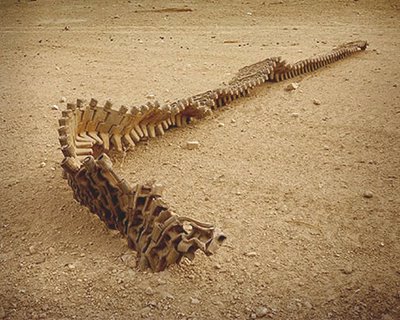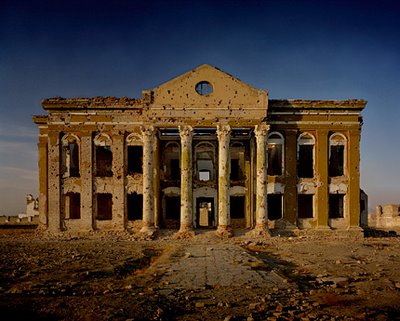European art has long had a fondness for ruin and desolation that has no parallel in other cultures. Since the Renaissance, artists such as Claude Lorraine and Caspar David Friedrich have painted destroyed classical palaces and gothic churches, bathed in a fading golden twilight. These motifs symbolised that the greatest creations of civilisation – the Empires of Rome and Greece or the Catholic Church - even these have no permanence. Eventually, they too would crumble; vanquished by savages and vanishing into the undergrowth.
Afghanistan is unique, utterly unlike any other war-ravaged landscape. In places destroyed in the recent US and British aerial bombardment, the buildings are twisted metal and charred roof timbers (the presence of unexploded bombs deters all but the most destitute scavengers) giving the place a raw, chewed-up appearance.













Norfolk writes-
Afghanistan is unlike Sarajevo or Kigali or any other war-ravaged landscape I have ever photographed. In Kabul, in particular, the devastation has a bizarre layering …I was reminded of the story of Schliemann 's discovery of the remains of the classical city of Troy in the 1870s: digging down, he found nine cities layered upon each other, each one in its turn rebuilt and destroyed. Walking a Kabul street can be like walking through a Museum of the Archaeology of War -different moments of destruction lie like sediment on top of each other. There are places near Bagram Air Base or on the Shomali Plain, where the front line has passed back and forth eight or nine times -each leaving a deadly flotsam of destroyed homes and fields seeded with landmines.
The landscapes of Afghanistan are the scenes that I knew first from the 'Illustrated Children's Bible' given to me by my parents when I was a child. When David battled Goliath,these mountains and deserts were behind them …More accurately, these landscapes are how my childish imagination pictured the Apocalypse: utter destruction on a massive, Babylonian scale, bathed in the crystal light of a desert sunrise.
Questions:
- Norfolk photographs with a large, cumbersome, wooden camera that is very different than the small SLR-type cameras most photojournalists use. How does this make his images different from a typical journalistic image you would see in a newspaper?
- How do you think Norfolk's images reflect the sense of "walking through a Museum of the Archaeology of War?"
- How would you compare Norfolk's work to that of Edward Burtynsky, in Ch. 3?

12 comments:
It's kind of sad to see how we are trashing one of the ancient places of the world. I would have thought with it having a historical religious background in the Bible that people would be more careful, but I guess in the name of freedom and anti-terrorism that doesn't matter very much. Some of these are really beautiful too. It's amazing how Norfolk could take something that is so destroyed and find a way to make it so visually appealing.
He's showing destruction, but somehow it doesn't seem as intense because we are seeing the aftermath. This certainly makes them easier to look at. I think that with being so used to seeing all of the violence in new coverage on the television, it makes these more meaningful to look at. I can get more from these personally than watching people shooting at each other. These show more of a long term affect of the conflict going on and it's sad to see the deterioration of any place of historical signifigance.
as holly said, it is a little upsetting to view these pictures. however, they have a sort of beautiful painterly quality. I believe cotten touched on how it remenences old english painings of ruins. I have to agree they all have that mystical feeling you get when viewing ruins of past cultures or even mythological cultures. The distruction of temples and holy establishments occured and are dipicted in many paintings. so, even though they destroyed the holy places here, they retain their sanctity.
The way Norfolk uses angles and emphasizes textures makes the images more interesting. He takes devestation and makes it interesting to look at. The use of angles when he photographed these destroyed places make them so much more visually interesting. They are haunting images because the viewer knows the awful events that must have preceeded these images.
It is very sad to see how these precious places are treated like they're hardly anything. By taking these pictures, he is recording down history and what we are doing to ruin it. It is hard to find many people who really care about such historic places and fewer willing to go through to protect them.
I'm particularly impressed with Norfolk's use of lighting. He seems to shoot his subjects at just the right time of day to give his work a "calm after the storm" feeling. Furthermore, art loves contrast and extremes, a concept that Norfolk has mastered i.e. the calming light vs. the destruction-based imagery. Perhaps the most effective photo in this collection is the man with the balloons. He looks almost as if he has been photoshopped into this Stone Hinge-like structure that looks almost like ancient ruins. The contrast of the brightly colored balloons make the destruction that much more tragic.
These photos provide a sense of destruction, death, people loosing thier homes, family, and devistation of war. And in that light, they are a frightening reality of war and its effects, that we as americans are so far removed from, although we to experience the losses and effects of war, just differently.
In another way, these images are beautiful. The color, the landscapes, the destroyed buildings have such rich and vivid imagery and story.
these images are like walking through a museum of the archaeology of war because as you looking through the images, it is like you are walking through the streets and are seeing the destruction like you see art work in a museum. i don't know if it is the type of camera he uses or if it is just the compositions and lighting he chooses when taking the photographs, but they are very beautiful, unlike the photojournalism photos. they have a certain grandure to them that newspaper photos don't have. usually people just throw newspapers away and so the photos are not very high quallity and are often just looked at once and then forgotten. These images are not ones that you just look at once and then forget.
Looking at these images is a bit like a museum. When I look at them, I feel a little depressed. I don't think it would be incorrect to say that these places were once "alive", and that's how I'd like to see them - not like they are now. I wish I could see human beings interacting with these environments. I guess that means I'm saddened by the fact that they've been ravaged by war too.
I think more than anything I'm saddened because I'll never get an opportunity to see the people who would frequent these places.
I've never seen or used a wooden camera, but whatever its mechanisms are I am sure it is worth the bulk. These images are gorgeous, exceptionally vivacious for such a decrepit scene. I assume that the format of the film possibly has something to do with the technical outcomes. Everything looks so detailed and rich, the colors simply emanate.
Most of the photographs reflect a vastness of space, nature reflecting its wonders. The skies hint at a possibility of greatness, yet when you look at the structures you see the effects of ignorance. Only humans and their hate can destroy with such conviction.
-Shyma El Sayed
The sandy color and the obvious destruction make the scenes seem almost ancient. Even the pictures with pieces of planes look as if they are decades old. The centered composition of the subjects in these photos make them seem like they were documented for a museum or report.
These photographs are very moving to me, and I believe could be the sort of thing to improve spirits and relations between waring countries. The images depicted are so powerful that they seem to inspire admiration of the country on display. They show a land worth of sympathy from the viewer, which has the potential to sway the popular opinion of the enemy and cause them to change their feelings toward a more diplomatic nature.
-Zach Phillips
Post a Comment